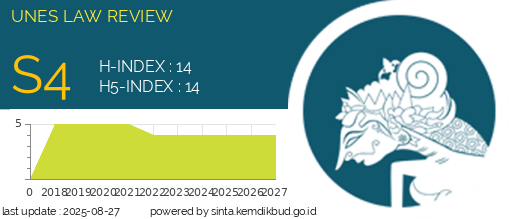Tinjauan Hukum Penyediaan dan Pengelolaan Ruang Terbuka Hijau berdasarkan Prinsip Good Environmental Governance di Kabupaten Karawang
DOI:
https://doi.org/10.31933/unesrev.v6i1.625Keywords:
Green Open Space, Good Environmental Governance, Environmental Governance, Local RegulationsAbstract
This research discusses the relationship between green open space (RTH) and good environmental governance (good environmental governance). Good environmental governance is an extension of good government, which refers to the principles of good governance in the context of the environment. The government's role in providing green open space that can be enjoyed by the wider community is closely related to public policy making. This public policy involves a policy-making process that leads to certain goals and involves steps taken by the government. Green open space has various benefits, both ecologically, socio-culturally, and aesthetically. Green open space provides comfort, improves the microclimate, increases oxygen reserves, and serves as a means of recreation, social interaction and regional identity. The existence of green open space is also important in maintaining a balance between the natural environment and the built environment in urban areas. In managing green open space, it is important to apply the concept of good environmental governance by taking into account the sustainability of natural resources. Environmental governance understands environmental management through interactions between the state and its people. Green open space management also involves the process of planning, utilization and control which plays an important role in forming a planned urban spatial layout. This study focuses on Karawang Regency, where there is an imbalance between the amount of green open space with public facilities and private buildings. Even though there is still empty land that can be used as green open space, its utilization has not been optimal. In the Karawang Regency strategic plan, an analysis of land use and green open space needs is carried out based on the area and population. Good green open space management efforts in Karawang Regency can help achieve good environmental governance and improve the quality of the environment and the quality of life of its people.
Downloads
References
De Schutter, O. (2011). The green rush: The global race for farmland and the rights of land users. Harv. Int’l LJ, 52, 503.
Dwihatmojo, R. (2016). Ruang terbuka hijau yang semakin terpinggirkan. Dalam Http://Www. Bakosurtanal. Go. Id/Assets/Download/Artikel/BIGRuangTerbukaHijauyangSema KinTerpinggirkan. Pdf, Diakses Tanggal, 4.
Maranjaya, A. K. (2022). Good Governance Sebagai Tolak Ukur Untuk Mengukur Kinerja Pemerintahan. Jurnal Sosial Teknologi, 2(11), 929–941.
Muljono, S. (2008). Pendidikan Lingkungan hidup Bagi Pimpinan Aparatur Pemerintahan Dalam Mewujudkan Good Governaance. Jurnal Widyaprana, 1(2).
Ong, D. M. (2001). The impact of environmental law on corporate governance: international and comparative perspectives. European Journal of International Law, 12(4), 685–726.
Peramesti, N. P. D. Y. (2017). PENERAPAN PRINSIP-PRINSIP GOOD ENVIRONMENTAL GOVERNANCE DALAM PENGELOLAAN RUANG TERBUKA HIJAU DI KOTA ADMINISTRASI JAKARTA SELATAN. JURNAL MP (MANAJEMEN PEMERINTAHAN).
Pratiwi, B., & Purnomo, E. P. (2021). Analisa Undang-Undang 26 Tahun 2007 terhadap Penyediaan Ruang Terbuka Hijau Berdasarkan Prinsip Good Environmental Governance Di Kota Yogyakarta. Wajah Hukum, 5(1), 77–87.
Purniawati, P., Kasana, N., & Rodiyah, R. (2020). Good Environmental Governance in Indonesia (Perspective of Environmental Protection and Management). The Indonesian Journal of International Clinical Legal Education, 2(1), 43–56.
Purnomohadi, S. (1995). Peran Ruang Terbuka Hijau dalam Pengendalian Kualitas Udara di DKI Jakarta.
Putri, C. D. (2011). Peran Pemerintah Daerah Dalam Mengelola Ruang Terbuka Hijau Dengan Perspektif Good Environmental Governance (Studi Di Kota Madiun). Brawijaya University.
Rahayu, M. I. F., Susanto, A. F., & Muliya, L. S. (2014). Model Pemberdayaan Hukum Lingkungan Religius–Kosmik Sebagai Upaya Pelestarian Fungsi Lingkungan Hidup. LITIGASI, 15(1).
Rosidin, U. (2010). Otonomi daerah dan desentralisasi: dilengkapi Undang-Undang nomor 32 tahun 2004 dengan perubahan-perubahannya. Pustaka Setia.
Sadyohutomo, M. (2008). Manajemen kota dan wilayah: realita & tantangan. Bumi Aksara.
Siahaan, N. H. T. (2004). Hukum lingkungan dan ekologi pembangunan. Erlangga.
Sukismo, B. (2008). Karakter penelitian hukum normatif dan sosiologis. Penerbit Puskumbangsi Leppa UGM, Yogyakarta.
Yustika, S. A., & Priyana, P. (2022). ANALISIS PENGELOLAAN RUANG TERBUKA HIJAU DALAM TATA RUANG PERKOTAAN PADA KAWASAN PERUMAHAN DI KABUPATEN KARAWANG. Jurnal Justitia: Jurnal Ilmu Hukum Dan Humaniora, 9(2), 1087–1094.
Downloads
Published
How to Cite
Issue
Section
License
Hak cipta :
Penulis yang mempublikasikan manuskripnya di jurnal ini menyetujui ketentuan berikut:
- Hak cipta pada setiap artikel adalah milik penulis.
- Penulis mengakui bahwa UNES Law Review berhak menjadi yang pertama menerbitkan dengan lisensi Creative Commons Attribution 4.0 International (Attribution 4.0 International CC BY 4.0) .
- Penulis dapat mengirimkan artikel secara terpisah, mengatur distribusi non-eksklusif manuskrip yang telah diterbitkan dalam jurnal ini ke versi lain (misalnya, dikirim ke repositori institusi penulis, publikasi ke dalam buku, dll.), dengan mengakui bahwa manuskrip telah diterbitkan pertama kali di Jurnal UNES Law Review.



















